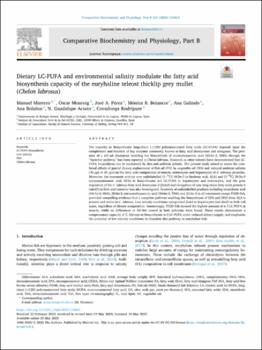Dietary LC-PUFA and environmental salinity modulate the fatty acid biosynthesis capacity of the euryhaline teleost thicklip grey mullet (Chelon labrosus)
Fecha
2024Resumen
The capacity to biosynthesise long-chain (≥C20) polyunsaturated fatty acids (LC-PUFA) depends upon the
complement and function of key enzymes commonly known as fatty acyl desaturases and elongases. The presence of a Δ5/Δ6 desaturase enabling the biosynthesis of docosahexaenoic acid (22:6n-3, DHA) through the
“Sprecher pathway” has been reported in Chelon labrosus. Research in other teleosts have demonstrated that LCPUFA biosynthesis can be modulated by diet and ambient salinity. The present study aimed to assess the combined effects of partial dietary replacement of fish oil (FO) by vegetable oil (VO) and reduced ambient salinity
(35 ppt vs 20 ppt) on the fatty acid composition of muscle, enterocytes and hepatocytes of C. labrosus juveniles.
Moreover, the enzymatic activity over radiolabelled [1-14C] 18:3n-3 (α-linolenic acid, ALA) and [1-14C] 20:5n-3
(eicosapentaenoic acid, EPA) to biosynthesise n-3 LC-PUFA in hepatocytes and enterocytes, and the gene
regulation of the C. labrosus fatty acid desaturase-2 (fads2) and elongation of very long chain fatty acids protein 5
(elovl5) in liver and intestine was also investigated. Recovery of radiolabelled products including stearidonic acid
(18:4n-3, SDA), 20:5n-3, tetracosahexaenoic acid (24:6n-3, THA) and 22:6n-3 in all treatments except FO35-fish,
provided compelling evidence that a complete pathway enabling the biosynthesis of EPA and DHA from ALA is
present and active in C. labrosus. Low salinity conditions upregulated fads2 in hepatocytes and elovl5 in both cell
types, regardless of dietary composition. Interestingly, FO20-fish showed the highest amount of n-3 LC-PUFA in
muscle, while no differences in VO-fish reared at both salinities were found. These results demonstrate a
compensatory capacity of C. labrosus to biosynthesise n-3 LC-PUFA under reduced dietary supply, and emphasise
the potential of low salinity conditions to stimulate this pathway in euryhaline fish.






